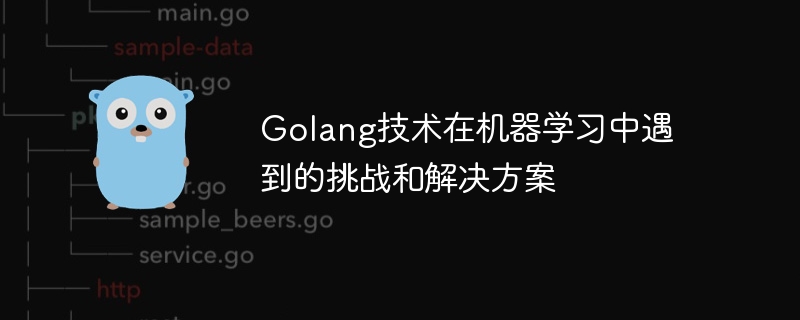Golang技術在機器學習中遇到的挑戰和解決方案
- 王林原創
- 2024-05-08 15:30:021065瀏覽
Go 語言在機器學習中面臨挑戰:缺乏機器學習函式庫、資料結構限制、缺乏 GPU 支援。解決方案包括:利用第三方函式庫,例如 GoML 和 gonum;利用 Go 協程實作平行處理;探索雲端運算服務的 GPU 實例。實戰案例展示了使用 Go 開發影像分類模型,包括影像載入、灰階轉換、資料矩陣化、模型訓練和評估。

Go 技術在機器學習中遇到的挑戰和解決方案
Go 是一種流行的通用程式語言,以其並發性和高性能而聞名。雖然 Go 在機器學習領域極具潛力,但它也面臨一些獨特的挑戰。
挑戰
- 缺乏機器學習函式庫:與 Python 等其他流行的 ML 語言相比,Go 缺乏成熟的機器學習函式庫。這使得開發人員很難在 Go 中建立複雜的 ML 模型。
- 資料結構限制:Go 中的資料結構相對有限,這可能會限制在記憶體中操作大型資料集的能力。
- 缺乏 GPU 支援:Go 對 GPU 的支援有限,而 GPU 是訓練 ML 模型的常用硬體。
解決方案
- 尋求第三方函式庫:雖然Go 本身缺乏機器學習函式庫,但existem第三方函式庫可用於彌補這一差距。例如,[GoML](https://github.com/robertkrimen/goml) 和 [gonum](https://github.com/gonum/gonum) 提供了各種機器學習演算法和資料結構。
- 利用 Go 協程:Go 的協程可以利用多核心處理器來並行處理任務。這可以提高大型資料集的處理速度,部分彌補了資料結構限制。
- 探索雲端運算服務:雲端運算服務,如Amazon Web Services (AWS) 和Google Cloud Platform (GCP),提供了強大的GPU 實例,可用於訓練Go 中的ML模型。
實戰案例
考慮使用Go 開發一個影像分類模型的範例:
import (
"fmt"
"image"
"image/jpeg"
"log"
"os"
"time"
"github.com/gonum/gonum/mat"
)
func main() {
// 加载图像
file, err := os.Open("image.jpg")
if err != nil {
log.Fatal(err)
}
defer file.Close()
img, err := jpeg.Decode(file)
if err != nil {
log.Fatal(err)
}
// 转换为灰度图像
bounds := img.Bounds()
gray := image.NewGray(bounds)
for y := bounds.Min.Y; y < bounds.Max.Y; y++ {
for x := bounds.Min.X; x < bounds.Max.X; x++ {
gray.Set(x, y, img.At(x, y))
}
}
// 转换为矩阵
data := make([]float64, bounds.Max.X*bounds.Max.Y)
for y := bounds.Min.Y; y < bounds.Max.Y; y++ {
for x := bounds.Min.X; x < bounds.Max.X; x++ {
data[y*bounds.Max.X+x] = float64(gray.At(x, y).Y)
}
}
dataMat := mat.NewDense(bounds.Max.Y, bounds.Max.X, data)
// 训练模型
model := LogisticRegression{}
start := time.Now()
model.Train(dataMat, labels)
fmt.Printf("训练时间:%s", time.Since(start))
// 评估模型
start = time.Now()
accuracy := model.Evaluate(dataMat, labels)
fmt.Printf("评估时间:%s\n", time.Since(start))
fmt.Printf("准确率:%.2f%%\n", accuracy*100)
}在這個範例中,我們使用了Gonum 函式庫來讀取和轉換圖像。然後,我們將資料轉換為矩陣並使用 LogisticRegression 模型。此模型使用 Go 協程進行平行訓練,以加快處理速度。
以上是Golang技術在機器學習中遇到的挑戰和解決方案的詳細內容。更多資訊請關注PHP中文網其他相關文章!
陳述:
本文內容由網友自願投稿,版權歸原作者所有。本站不承擔相應的法律責任。如發現涉嫌抄襲或侵權的內容,請聯絡admin@php.cn

